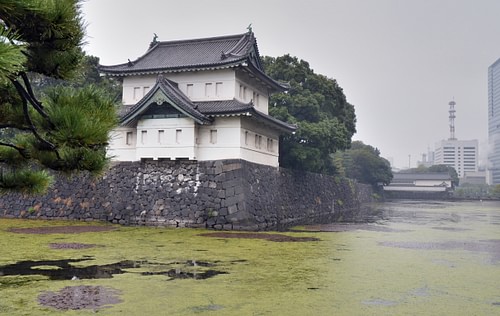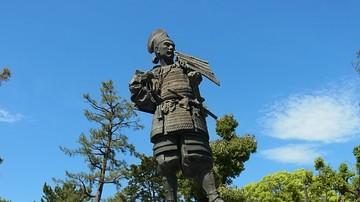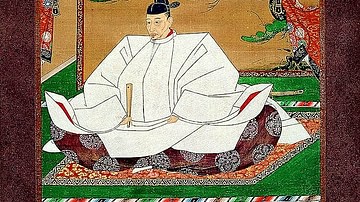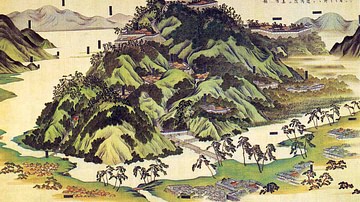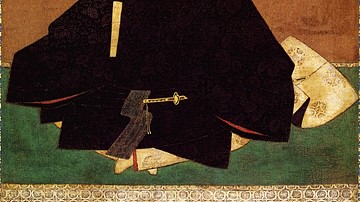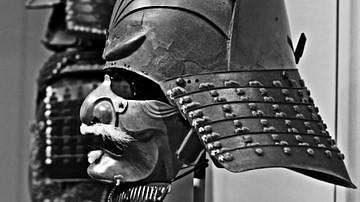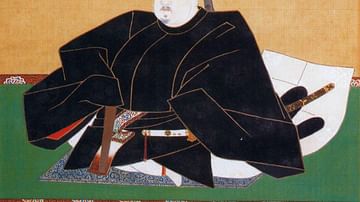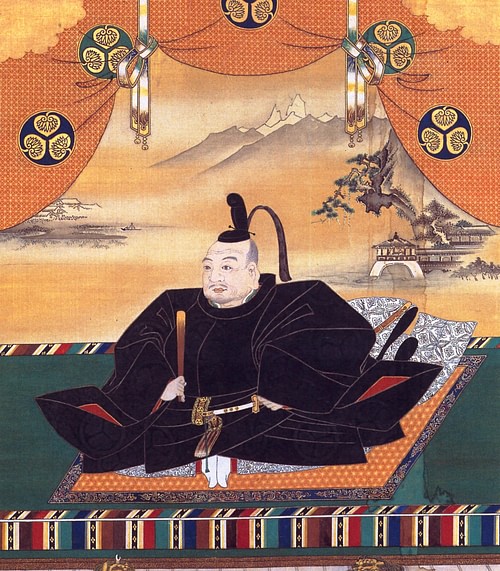
Tokugawa Ieyasu (1543-1616) was a Japanese military leader who reunified Japan at the beginning of the 17th century after a long period of civil war, known as the Warring States or Sengoku period. He created a new government controlled by the Tokugawa family that ruled Japan until 1868.
Rise to Power
Ieyasu, whose real name was Matsudaira Takechiyo, was born in 1543 in Okazaki Castle near the modern city of Nagoya. The Matsudaira were a warrior family that claimed ancestry back to the Minamoto clan that had ruled Japan in the Kamakura period (1185-1333). The 16th century is referred to as the Warring States or Sengoku period, as it was a time of civil war in which local warrior leaders called daimyo competed for power and control of land. Treachery was common not only between families but even within them. To cement alliances, families would often swap hostages, and for that reason, Ieyasu spent many years away from his family as a child.
Following his first battle in 1558, he gradually strengthened his family's position through an alliance with Oda Nobunaga (1534-1582), a powerful warrior who was taking the first steps to reunify Japan. Ieyasu engaged in a long series of campaigns against the rival Takeda family, and this led to their eventual defeat in 1582. In the same year, Oda Nobunaga was murdered by one of his own retainers and, in the confusion that followed, Toyotomi Hideyoshi (1537-1598) emerged as the strongest military leader in Japan. Although initially hostile to Hideyoshi, in 1590, Ieyasu formed an alliance with him in order to attack the Hojo family, a powerful clan that controlled a lot of land in the Kanto area in eastern Japan.
Following the Hojo’s defeat, Hideyoshi offered to give Ieyasu control of the eight provinces in the Kanto region in exchange for the five provinces he already had in central Japan. In one sense, this was a reward because it would increase the amount of land in Ieyasu's possession, but on the other hand, it would also weaken his position. The land was further from the capital of Kyoto (Heiankyo) than his existing territory, and his control of it would also be less secure as his family had no traditional connections to the area. Ieyasu decided to accept the offer because, to do otherwise, would have meant war with Hideyoshi. Ieyasu established his headquarters in a small fishing village called Edo where he began the construction of a castle. In the 1590s, as Hideyoshi dissipated his strength in two disastrous military campaigns in Korea, Ieyasu consolidated his control over the Kanto region.
In 1598, Hideyoshi became ill and, anticipating his own death, he established a Council of Five Elders to govern until his five-year-old son Hideyori would be old enough to rule. Ieyasu was the most powerful of the five elders and, after Hideyoshi's death, he used his position to try and seize power for himself. Gradually the major daimyo divided into two groups. Those in western Japan mostly supported Hideyori, while those in the east mostly support Ieyasu. In October 1600, there was a great battle between the two sides at Sekigahara near Lake Biwa in central Japan. Ieyasu was victorious, and he became the de facto ruler of Japan.
A New Government
Ieyasu used his victory as an opportunity to radically redistribute land. He confiscated the land of those daimyo he regarded as implacable enemies. Some of this he kept for himself, and some was awarded to his supporters. He also weakened other daimyo by moving them away from their traditional areas to new lands. Hideyoshi's son, Hideyori, was allowed to remain in Osaka Castle although his territory was also greatly reduced.
In 1603, Ieyasu had the emperor appoint him as shogun. This title had been used by Minamoto no Yoritomo (1147-1199) when he established the first warrior government in Kamakura in the late 12th century. In Japanese, warrior governments were called bakufu, which literally means "tent government". After the Minamoto clan was overthrown in 1333, the Ashikaga family established a new bakufu in the Muromachi area of Kyoto. This survived in a weakened form down to 1573 when Oda Nobunaga finally destroyed it. Ieyasu established the third warrior government in Japanese history and it is called the Tokugawa or Edo bakufu.
The period of warrior rule is sometimes referred to as feudalism in medieval Japan, but this term can cause misunderstanding. In Europe, feudalism appeared after the collapse of the Roman Empire, but in Japan, the imperial system created in the Nara period (710-794) never came to an end. Although the imperial family rarely had any real political power, by conferring titles like that of shogun, it could provide political legitimacy for warrior rule, and this was very important for people like Ieyasu. It gave him the authority to create a new kind of government, one that would last for more than 250 years.
After the Battle of Sekigahara, the Tokugawa directly controlled about 30 % of the country, but the rest was in the hands of local daimyo families. Ieyasu recognised the hereditary right of these families to govern in their local area in exchange for them recognising the authority of the Tokugawa at a national level. Modern historians call the land a daimyo ruled a han. The size of han was determined not by area but by the amount of rice it produced measured in a unit called a koku. To qualify as a daimyo, a person had to control land that produced more than 10,000 koku.
Ieyasu created a system in which there were three kinds of daimyo families:
- shinpan families – directly related to the Tokugawa
- fudai families – who had been allied to the Tokugawa before the Battle of Sekigahara
- tozama families – who had not been Tokugawa's allies
The territories of fudai daimyo were typically small but located in strategically important places along major roads. The lands of the tozama daimyo were larger, some more than a million koku, but they were located far from the political centre in western and northern Japan. Warriors from the fudai families could hold office within the bakufu, but those from the tozama families could not. In addition to redistributing land, Ieyasu implemented a number of policies aimed at limiting the power of the daimyo. The size of daimyo armies was restricted, they were only allowed to have one castle in their territory, and any repairs to fortifications needed approval. A hereditary four-tier class system was also created with warriors at the top, followed by farmers, artisans and merchants. Historians call this power structure the bakuhan system because it was made up of the bakufu and the han. Ieyasu skilfully created a system in which he and his successors could maintain the balance of power in the Tokugawa family's favour.
In 1605, Ieyasu gave up the title of shogun so that it could be conferred on his son, Hidetada. He did this for two reasons. Firstly, he wanted to establish the principle that the Tokugawa had a hereditary right to the position of shogun. Secondly, he wanted to free himself from the day-to-day tasks the position required so he could focus on consolidating the power of the Tokugawa family. After his retirement, Ieyasu moved to Sunpu in modern-day Shizuoka Prefecture where he established a shadow government that would allow him to continue to govern the country.
The Development of Edo
The period of national unification from 1573 until 1600 is known as the Azuchi-Momoyama period. Azuchi was the location of a large castle built by Oda Nobunaga near the shores of Lake Biwa, and Momoyama was the name of a castle built by Toyotomi Hideyoshi near Kyoto. Ieyasu also engaged in large-scale construction projects. The greatest of these was Edo Castle. When Ieyasu had originally entered Edo in 1590, it was just a small fishing village near the ruins of a castle that had been built in the 15th century. Ieyasu supervised the construction of a new castle, and this involved flattening hills, filling in marshes and the construction of canals to provide both transport and drinking water. After he became shogun, he decided to keep his headquarters in Edo rather than move to the capital of Kyoto. He ordered various daimyo to provide both the labour and resources necessary for the construction of a very large castle surrounded by a double layer of moats. This both provided him with a splendid residence worthy of his position and weakened rival military families. A city quickly grew up around the castle, and by 1605, Edo had a population of 150,000.
Many daimyo built lavish houses on the highland around the castle while ordinary people lived on the low land near the Sumida River. After the Tokugawa were overthrown in 1868, Edo became the official capital of Japan and was renamed 'Tokyo', which means "eastern capital". Edo Castle became the home of the imperial family and was renamed the 'Imperial Palace'. The Imperial Palace still lies at the centre of Tokyo and its stonewalls and moats are a reminder of the power of the Tokugawa family although the present grounds are only about one-third the size of the original castle ones. Ieyasu also oversaw the construction of Nijojo Castle in Kyoto. This was used as the headquarters for the Tokugawa family in western Japan.
Although Ieyasu forced daimyo to pay for the construction of castles and other large projects, he did not directly tax the income they earned from their land. As a result, he had to pay the cost of running the national government from revenue derived from Tokugawa land. Most of this came from taxes on the farming population, but mining became increasingly important. Ieyasu took direct control of most of the large silver mines in Japan. He also cultivated relations with foreign merchants as international trade was another important source of wealth. Trade was not only with China and Korea but also with various European countries. Europeans had first come to Japan in the 1540s and brought with them new forms of culture, including muskets and Christianity. Although Ieyasu valued foreign trade, he was also concerned that his domestic rivals may seek support from abroad. For that reason, he was cautious in his dealings with foreigners.
Final Years
While Ieyasu was consolidating his control over Japan, Hideyoshi's son, Hideyori, continued to live in Osaka. In 1614, Ieyasu found an excuse to attack Osaka Castle, which Hideyori had just rebuilt. The initial campaign was indecisive, but in the subsequent negotiations, Hideyori agreed to fill in the outer moats of the castle in exchange for a promise of peace. In the following year, however, Ieyasu reneged on his promise and launched another attack. In the ensuing fighting, Hideyori was killed and Osaka Castle was destroyed. This was the last battle of Ieyasu's life as he died in 1616 at the age of 75. After his death, a spectacular mausoleum was built in Nikko (in modern Tochigi Prefecture north of Tokyo) and Ieyasu's spirit was enshrined there.
Ieyasu was one of the most important figures in Japanese history. He was both a great warrior and a skilled politician who created a political system that lasted for more than 250 years.


